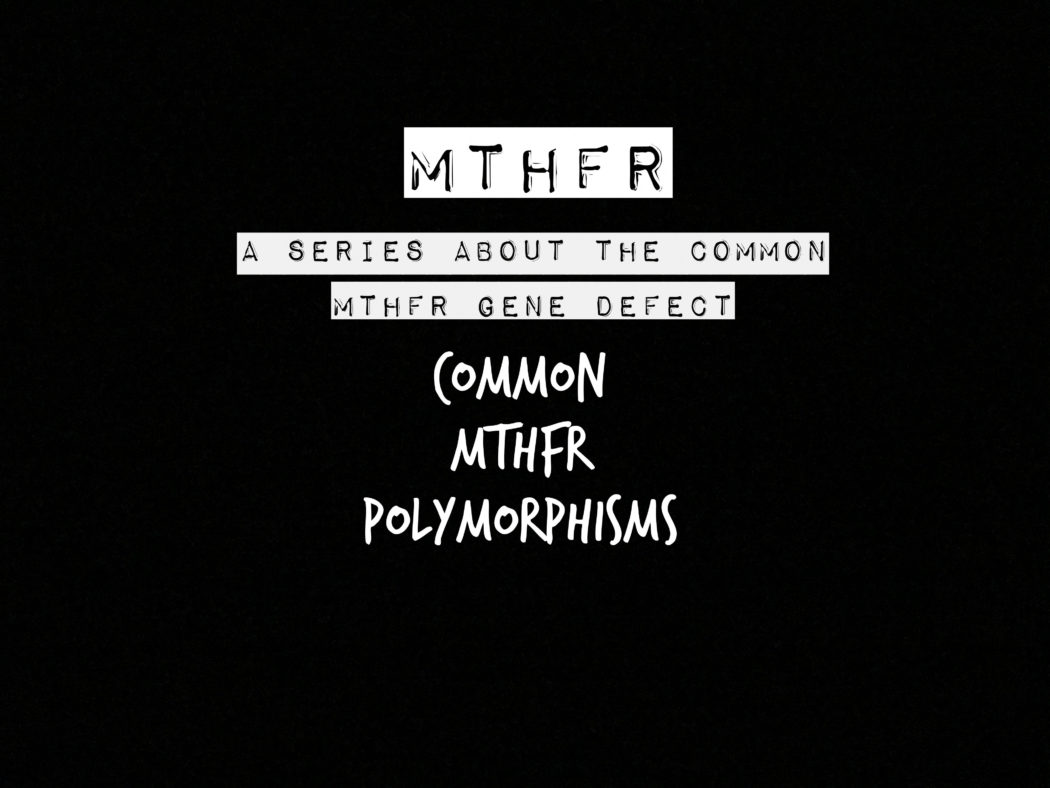As I wrote here, I’m currently researching the MTHFR gene defect. I want to find out if and how it has something to do with my current health problems. Thus, I thought it would be best to break down the information I gather during my research in a series of posts. That way, I can present the information on this complex subject in a more easily digestible way by writing about different aspects one at a time.
Start from the beginning here and/or see all posts of the series here.
Today, I am writing about the different MTHFR polymorphisms and how these can affect your health and well-being in different ways.
The information I present here is simply as I came to understand it through my research. I’m not an expert by any means.
MTHFR Gene Mutations
The two most researched defects on the MTHFR gene are called C677T and A1298C. The combination of numbers and letters refer to the location on the gene where the mutation is found. Genes come in pairs (two copies). Simply put, genes get passed down by your parents and you (almost) always receive one copy from your mother and one copy from your father. As a result of that, a defective MTHFR gene can take on many different combinations. I’m breaking them down in the following paragraphs.
Heterozygous Mutations
You either have one mutation at the C677T or the A1298C position. The mutation (defective copy) was either passed down from your mother or father (plus a normal copy from the other parent). In cases like that, the MTHFR gene and enzyme is functioning at 55-70% capacity compared to a normal MTHFR with no mutation. Possible combinations:
- Heterozygous A1298C (i.e., one of your parents passed down a single 1298 mutation)
- Heterozygous C677T (i.e., one of your parents passed down a single 677 mutation)
Homozygous Mutations
You have two mutations at the C677T or two mutations at the A1298C position. You received one mutation from each of your parents. In a case like that, the MTHFR gene and enzyme is functioning at only 7-10% capacity compared to a normal MTHFR with no mutation. Possible combinations:
- Homozygous A1298C (i.e., both of your parents passed down the 1298 mutation)
- Homozygous C677T (i.e., both of your parents passed down the 677 mutation)
Compound Heterozygous Mutation
You have one mutation at the C677T position and one mutation at the A1298C position (that’s the one I have). You received one mutation from each of your parents. This combination is more severe than the ones mentioned above because you get the risks and symptoms of both mutations. (As a side note, 98% of all autistic children are compound heterozygous.)
Other (More Rare) Mutations
The five combinations mentioned above are the most common ones. Other combinations are pretty rare but I’m listing them here for completion:
- Heterozygous C677T / Homozygous A1298C (i.e., one of your parents passed down the 677 mutation and both passed down the 1298 mutation)
- Homozygous C677T / Heterozygous A1298C (i.e., both of your parents passed down the 677 mutation and one passed down the 1298 mutation)
- Compound Homozygous (i.e., both of your parents passed down the 677 mutation and both also passed down the 1298 mutation)
Difference Between C677T and A1298C Mutation
Depending on which position you have a MTHFR mutation, you have different health conditions and symptoms associated with it. If you’re compound heterozygous, risks and symptoms of both mutations apply.
C677T Mutation Risks
If you have a mutation at the C677T position, you’re at a higher risk for the following conditions:
- Heart disease
- Heart attack
- Stroke
- Blood clots
- Peripheral neuropathy
- Anemia
- Miscarriages
- Congenital birth defects
A1298C Mutation Risks
If you have a mutation at the A1298C position, you’re at a higher risk to develop chronic illnesses, such as:
- Depression
- Anxiety
- Schizophrenia
- Fibromyalgia
- Chronic fatigue syndrome
- Migraines
- IBS (Irritable Bowel Syndrome)
- Memory loss
- Alzheimer’s and Dementia
- Parkinson’s
- OCD
- Bipolar disorder
- Nerve pain
Symptoms Related To Both A1298C And C677T
- Difficulty eliminating heavy metals
- Increased cancer risk
- Renal failure
- Addiction potential
All of the above conditions are only examples of the most severe ones. However, there are many more issues, conditions and symptoms that are associated with either of the two MTHFR mutations.
This may all sound a bit demoralizing and scary. However, there are certain measures you can take (pertaining to diet, lifestyle and taking supplements) that can help reduce the risks associated with an MTHFR defect. Stay tuned for a future post on that topic.
(Sources used for this post: MTHFR.net, rawlins.org, Freshideamama.com, stopthethyroidmadness.com)

